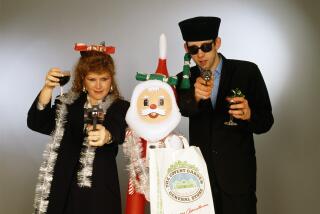Fairy Tales : For Most of Us, Fairies Are--at Best--Cute. But Some People Take Them Quite Seriously
- Share via
“It’s not an electrifying film,” said critic Roger Ebert, reviewing the ballet movie “Nutcracker”-- “but then, how electrifying can a Sugar Plum Fairy be?”
For most of us, fairies are funny--at best, cute; but some people have taken them very seriously indeed. The most unlikely folk have believed in fairies at the bottom of the garden. Sir Arthur Conan Doyle, creator of the keenest analytic mind in all detective fiction, was himself completely bamboozled by some faked photographs that purported to represent fairies materializing in an English country garden.
When President Reagan met Soviet leader Mikhail S. Gorbachev at Reykjavik, Iceland, in October, one newspaper columnist suggested that anything could happen in Iceland--a country in which, a survey had shown, 55% of the population believes in elves. And it doesn’t take much moonshine for an Irishman to spy leprechauns in the Celtic twilight.
But these are comparatively benign cases of feyness. Chronic, incurable feyness has never been more ghoulishly anatomized than by P. G. Wodehouse in his portrayal of the ineffable Madeline Bassett, daughter of Sir Watkyn Bassett of Totleigh Towers, Gloucestershire. She flits a-tiptoe through several of his novels, and only the savviest wiles of the butler, Jeeves, save Bertie Wooster from marrying her. (“The prospect of being linked for life to a girl who would come down to breakfast and put her hands over my eyes and say ‘Guess who’ had given my morale a sickening wallop,” Wooster says.)
Madeline dances on the lawn before breakfast, then goes round the garden saying “Good morning” to the flowers. She is convinced that the stars are “God’s daisy-chain” and that “every time a fairy blows its wee nose a baby is born.”
Actually, fairies can be quite robust. No one ever called Rumpelstiltskin a sissy; and the Billy Goats Gruff, with all their venturesomeness, could not underestimate the macho fellow under the bridge who sang in Chaliapin tones:
I’m a troll, fol-de-rol ,
I’m a troll, fol-de-rol ,
I’m a troll, fol-de-rol
And I’ll have you for supper.
But most fairies are skimpy creatures with gauzy wings. And fairies are predominantly female; though in 1898, in the Royal Academy, London, Charles Sims exhibited a painting called “A Fairy’s Wooing,” showing a male fairy suspended in the air like a Hovercraft as he rather unconvincingly embraces a girl fairy who is lying in the long grass. The understood femininity of fairies has caused the word to be used as a sneering synonym for homosexuals. In his 1956 novel “Thin Ice,” Compton Mackenzie deplored this debasement of the diaphanous word fairy . But the usage still obtains: In “An Officer and a Gentleman,” the 1982 movie, Louis Gossett Jr., as a Marine sergeant, asks a recruit (played by David Keith): “Are you a fairy?” Keith: “Hell, no, sir.”
Fairies can be upper-class; indeed, fairies can be royal--Edmund Spenser’s Faerie Queene, Shakespeare’s Oberon and Titania. British Prime Minister Benjamin Disraeli was even able to convert such unpromising material as the dumpy Queen Victoria into a “Faery” in letters of trowel-applied flattery. But in the 20th Century, fairies have become associated with suburbia, partly perhaps through plaster garden gnomes, an image that springs to most peoples’ minds when the word kitsch is mentioned. John Betjeman invoked the patron fairies of suburbia in “Indoor Games near Newbury,” a poem about going to a children’s party in the early 1920s.
Good-by Wendy!
Send the fairies,
pinewood elf and larch tree gnome,
Spingle-spangled
stars are peeping
At the lush Lagonda creeping
Down the winding ways of Tarmac to the leaded lights of home.
Another 20th-Century development has been the interpretation of fairyland in psychoanalytic terms. In 1972, Maureen Duffy, previously best known as a novelist, published her “The Erotic World of Faery,” in which gnomes in red caps were inevitably found to be phallic symbols.
Duffy thinks that the “world of faery” offered 19th-Century artists an outlet for sexual fantasy, a chance to evade taboos, an alternative to “the asexual mythology of Christianity.” The paintings of Henry Fuseli, Thomas Heatherley, Dicky Doyle, John Anster Fitzgerald and Richard Dadd seem to support such a thesis. There is something strange in the psychological makeup of most of these men, especially that of Richard Dadd, painter of the fanatically detailed “The Fairy Feller’s Master-Stroke.” Dadd painted some of his best works in a lunatic asylum, to which he was committed after murdering his father. Dadd was an artist of genius (albeit warped); but the depiction of fairies easily degenerates into sentimentality or into roaring kitsch , as in Arthur Barrett’s painting “The Fairy Prince.”
More to Read
Only good movies
Get the Indie Focus newsletter, Mark Olsen's weekly guide to the world of cinema.
You may occasionally receive promotional content from the Los Angeles Times.







